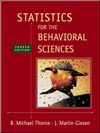 |  Statistics for the Behavioral Sciences, 4/e Michael Thorne,
Mississippi State University -- Mississippi State
Martin Giesen,
Mississippi State University -- Mississippi State
Definitions and Scaling
Problems- For each of the following brief descriptions, decide which is the independent variable and which is the dependent variable.
- Thirty people have been given one of three different kinds of drugs, and their responses on a standard IQ test have been recorded.
- A social psychologist studies the problem-solving performance of individuals working alone or working in the presence of others.
- One group of third-graders solves simple multiplication problems with odd-numbered answers. Another group of third-graders solves multiplication problems with even-numbered answers. The average number of seconds to solve the problems for each group is compared.
- In a study of visual acuity, participants view a standard stimulus under low illumination, moderate illumination, or high illumination. The length of time each participant takes to identify the stimulus is recorded.
- Give the appropriate measurement scale for each of the following:
- weight
- Social Security numbers
- scores assigned by a rating scale of authoritarian characteristics
- telephone numbers
- highway speed limits
- national college basketball ratings
- judges' ratings of gymnastics performance
- temperature centigrade
- Tell whether each of the following is a parameter or a statistic. Explain your choice.
- the average weight of all left-handed boys at Fairlawn High School
- the average ACT (or SAT) scores of 15 randomly selected students from your statistics class
- the range in IQ scores of all inmates in the state prison in your state
- the average income of a group of people selected by calling every 100th name in a small-town telephone directory
- Read each of the following and tell whether a descriptive statistical technique or an inferential statistical technique has been used.
- A commentator on the nightly business report uses a pie chart to show how the average American family spends its money.
- A newspaper article describes how a study of 27 Alzheimer's patients concluded that patients benefited from lecithin and physostigmine injections.
- A study based on a small sample concludes that calories consumed in a morning meal cause less weight gain than the same calories consumed at night.
- Your statistics instructor gives the range of scores and the average score on the midterm test.
- A study shows that law students who take special review courses perform better on the bar exam than students who do not take the courses.
- A newspaper publishes a graph showing the performance of the stock market in the month of July.
 Click here to view the answers (5.0K) Click here to view the answers (5.0K) |
|



 2003 McGraw-Hill Higher Education
2003 McGraw-Hill Higher Education